Abstract
Seepage forces due to the flow of water inside embankment hydraulic structures, such as dams or levees, result in internal erosion or piping. This will result in a reduction in soil strength, causing the failure of hydraulic structures. Stabilization of the soil is one of the most effective approaches to avoid such catastrophic failure and prevent significant loss of life and property. The objective of this research is to stabilize sandy soil against internal erosion using fly ash (FA) alone and fly ash mixed with alkali-activated binder (NaOH). Although fly ash is commonly used for clay soil, its reactivity with alkali activators like NaOH makes it a potential candidate for stabilizing non-cohesive sandy soils when combined with alkaline solutions. A well-graded sandy soil was selected and mixed with fly ash alone and fly ash with sodium hydroxide at different percentages. Compaction curves were determined for each percentage, and specimens from the mix were remolded at 98% relative compaction and optimum moisture content corresponding to the compaction curve value. The hole erosion test (HET) was employed to evaluate internal erosion parameters. During the hole erosion test, seepage conditions were simulated by applying a controlled water flow through remolded specimens to replicate erosion caused by internal seepage forces. Additionally, the internal erosion parameters were evaluated at different curing times (2 days, 7 days, and 28 days were selected to capture short-term, intermediate, and long-term effects of chemical reactions on soil stabilization). Parameters such as the friction factor, coefficient of soil erosion, and critical shear stress were obtained, and the erosion rate index (IHET) was determined. It was found that using FA–NaOH significantly reduced internal erosion and increased the erosion rate index and the critical shear of the soil. The addition of 10% fly ash mixed with activated-alkali binder at 7 days curing time stabilized the soil against erosion. At this percentage, the erosion rate index equal to 5.3 and soil was categorized as: “very slow erosion”. However, mixing the sand with fly ash alone has a small or insignificant effect on the internal erosion of the soil, especially at higher percentages of fly ash. The optimum percentage of fly ash alone to improve the soil resistance to internal erosion was found to be 5% at 28 days of curing time where the soil rated as “moderately slow”.
1. Introduction
Hydraulic earth fill structures can be used for many purposes such as flood control, irrigation, water supply, recreation, etc. Failures in such structures have a devastating impact on societies and urban life. These structures, such as levees, ponds, dams, and embankments, are constructed to control and change the natural behavior of water bodies by escalating their flow. Hydraulic structures could be water-retaining structures like dams, water-conveying structures like artificial channels, and others that have a special use like power generation, land reclamation, water supply, and waste disposal. Usually, retaining structures are constructed on the mainstream of a river or a canal and help to create a water head that allows water to flow down via gravity forces []. Therefore, such structures must be well constructed and stabilized to resist piping, washing, earthquakes, sliding, and slope failure, and crack requirements should also be considered.
Hydraulic structures are built from concrete or earth fill. The mechanism of failure is different between concrete and earth fill hydraulic structures. Hydraulic structures built from earth fill could fail under different circumstances, but mainly due to internal erosion []. The definition of internal erosion is the movement of soil particles due to water flowing through the soil; and it may occur if there are large enough cavities [] where small soil particles may be washed through and transported with water flow. This creates an open pathway for flow which may be referred to as piping []. Due to piping, hydraulic structures may fail within hours and that can cause a major catastrophe. Piping or internal erosion happens mainly when the resistance forces of soil become lower than water seepage forces and it takes place in four stages: the initiation of erosion, the continuation of erosion, progression or enlargement of the concentrated leak, and breach or failure []. Recent computational studies (e.g., [,]), which investigated load transfer and deformation in layered soil systems under strip footings, also highlight the role of subsurface layering in stress redistribution and potential failure initiation.
Nowadays, many countries are facing unexpected heavy rainfall because of global climatic changes. To prevent flooding in those countries, building dams is necessary as it is the best solution to keep rainwater away from urban areas. The earth fill or embankment dams are found to be relatively cheaper as they require mainly earth fill materials. Therefore, it is important to stabilize and protect such dams from any type of failure. Field applications of rapid impact compaction and dynamic replacement methods have shown success in stabilizing granular and reclaimed soils, particularly in infrastructure projects in coastal and artificial island developments [].
In recent years, significant attention has been given to the development of new soil stabilization materials and techniques aimed at improving erosion resistance. For instance, Agricultural Waste Biopolymers (AWBs) have demonstrated effectiveness in enhancing soil strength and reducing erosion by altering soil particle sizes through forming hydrogels that increase cohesion and shear strength. They also assist in controlling permeability, dust, and water filtration, contributing to overall soil conservation []. Moreover, while the use of biopolymers and natural polysaccharides continues to show potential, further studies are needed to optimize their application and long-term performance [].
There are many factors that affect the erosion phenomenon, such as water velocity inside the soil mass, the geometry of the earth structure, grain size, and the plasticity of fine soil. It was found that soil resistance against piping is higher in well-compacted high-plasticity clays more than well-graded coarse sand and sand–gravel mixtures [,,,,]. Also, it was found that the absence of some grain sizes in non-cohesive gap-graded soil erodes more due to the reduction in the strength and efficiency of shearing resistant forces []. Other physical soil factors affect the erodibility of the soil, such as the degree of compaction, homogeneity of the soil [], unit weight of soil, water content, void ratio, plasticity index, soil swell, pH of soil, clay minerals, percentage of soil passing sieve #200, and mineral composition of soil []. Recent findings also suggest that initial soil properties such as plasticity, unit weight, and fines content can be used as predictors for internal erosion potential, thus offering a practical approach for preliminary risk assessment in embankment design [].
It was found in the literature that approximately 30–50% of embankment failures are caused by the internal erosion of the soil [,,]. This high percentage raise an alarm for the need to stabilize the soil against internal erosion and stop catastrophic consequences of such failure. Several materials and techniques have been used in soil stabilization such as cement stabilization [,], lime stabilization [,,], bituminous stabilization [,,,], electrical stabilization [,], grouting [,], burned sludge stabilization [,,], sisal fiber stabilization [,], polypropylene stabilization [,], and compaction []. These materials and techniques are used to increase the shear strength properties, as well as to reduce the settlement, compressibility, and expansion of the soils. Additionally, advances in shear wave velocity measurements using bender elements during monotonic triaxial loading have provided valuable insights into the evolution of stiffness characteristics during soil improvement processes [].
Fly ash stabilization [] is also a well-known material to be used in soil stabilization used in soil. Fly ash is considered an artificial pozzolanic that reacts with lime to produce strength by cementation. The stabilization of soils using lime and fly ash is a well-known process that has been used in construction. The positive side of using fly ash to stabilize soil is the fact that it is a waste product of power plants and is available at low prices. However, lime is added to reach the optimum benefits of fly ash. This method has a cost comparable to that of other methods of soil stabilization []. Generally, fly ash reacts only with lime, but exploratory studies showed that some fly ashes produce strength without the existence of lime []. Experimental results of the study showed that certain classes of fly ash can strengthen the attraction of soil particles. Some studies also resulted in high strengths that could be used with dune sand during the construction of base and sub-base courses for road pavements [].
An experimental investigation was performed to evaluate the effect of adding fly ash with fine sand during compaction and the possibility of using the resulting material in dam embankments. The study assessed the role of fly ash content in stabilized soil physical characteristics and determined the optimum quantity of fly ash that can be used to stabilize this type of soil. This was achieved by performing size distribution and compaction tests. The sand was stabilized using three proportions of fly ash (5%, 10%, and 15%), and a fixed amount of cement of (3%) as an activator. The results showed an increase in the percentage of fly ash, a reduction in the maximum dry density and an increase in the optimum moisture content [].
The stabilization of soil by the addition of fly ash is an effective alternative for improving soil strength and stiffness through the resulting chemical reactions in the mixture. The chemical reaction that occurs dissociates the lime (CaO) in the fly ash; the establishment of cementations, pozzolanic gel, and calcium aluminate hydrate gel creates a stronger bond between the soil particles, therefore increasing the strength and stiffness of the soil. Investigations of the mechanical properties of the sand stabilized with fly ash were conducted over a series of unconfined compressive strength (UCS) and direct shear strength tests for several fly ash percentages with the consideration of curing time, grain sizes, the content of fines, and degrees of saturation of the sample during preparation. Overall, the results showed that fly-ash-stabilized sands need more than a month to reach their optimum performance regarding binding sand particles [].
According to the Organization for Economic Cooperation and Development (OECD), fly ash is listed on the green list of waste []. Therefore, it was found that fly ash has the potential to be used in agriculture because of its ability to improve soil health and productivity []. This is due to the fact that fly ash contains minerals that are needed in soil to grow crops (such as K, Na, Ca, Zn, Fe, and Mg), although the use of fly ash in agriculture is limited in comparison with other fields.
Few studies were found in the literature about soil stabilization against internal erosion. A recent study by Rodríguez and Cardoso [] used bio-cementation through enzymatically induced carbonate precipitation treatment to prevent soil erosion. The study concluded that the use of such material will prevent scour erosion. On the other hand, researchers have recently developed several tests to evaluate soil internal erosion such as the pinhole test [], jet erosion test [,], hole erosion test, and slot erosion test []. The development of these tests allow researchers to investigate the internal erosion phenomena in more depth and to understand the behavior of the failure mechanism throughout the failure process. In addition, interested researchers can use these tests to study the effect of different materials on internal erosion and to stabilize both cohesive and non-cohesive soils against internal erosion.
Recent advancements in the field have also explored the use of alkali-activated binders in conjunction with fly ash for enhancing soil resistance to internal erosion. When fly ash is activated using alkaline solutions such as sodium hydroxide (NaOH) or sodium silicate (Na2SiO3), it forms cementitious compounds like calcium silicate hydrate (C-S-H) and calcium aluminate hydrate (C-A-H) gels. These compounds bind soil particles together, improving their overall mechanical behavior and reducing vulnerability to erosion [,,]. The alkali activation process additionally induces microstructural changes by dissolving calcium-rich particles in fly ash, leading to the formation of new compounds that occupy pore spaces, resulting in a denser and stronger soil matrix [,,]. Further insights have been drawn from recent research on geopolymer concrete blends incorporating ground granulated blast furnace slag (GGBS) and silica fume (SF) []. The study demonstrated that carefully adjusting the GGBS-to-SF ratio and the sodium silicate-to-sodium hydroxide (SS-to-SH) ratio can significantly enhance the strength, stiffness, and overall workability of alkali-activated systems. Taken together, these insights reinforce the importance of tailored mix designs in achieving optimal engineering properties. Moreover, from a sustainability perspective, this approach offers substantial environmental benefits by reusing industrial by-products and reducing dependence on traditional Portland cement [,].
Internal erosion remains one of the leading causes of failure in sandy soil embankments and hydraulic structures, yet limited studies have explored effective stabilization techniques specifically targeting non-cohesive soils. While fly ash has been widely used for clay soil stabilization, its application in sandy soils, particularly in combination with alkali activators, is not well established. This research addresses this gap by investigating the potential of alkali-activated fly ash as a stabilizer for sandy soils. The main objective of this research is to study the potential use of fly ash and fly ash mixed with sodium hydroxide as an alkali-activated binder in stabilizing sandy soil against internal erosion. The study was performed on well-graded sandy soil mixed with fly ash alone and fly ash mixed with sodium hydroxide at different percentages and curing times. The hole erosion test was employed to evaluate the internal erosion parameters of the remolded specimen at different mixes. The data from the test were used to determine the erosion rate index and optimum value of fly ash and sodium hydroxide content and cure time to reach the stabilization of soil. The novelty of this study lies in applying the hole erosion test to quantify internal erosion in sandy soils treated with fly ash–NaOH mixtures, which has not been comprehensively investigated before.
2. Methodology
A well-graded sandy soil was selected and used in this research. The grain size distribution of the sand was determined. The grain size distribution is shown in Figure 1.
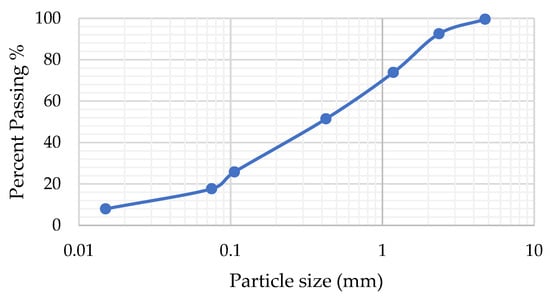
Figure 1.
Grain sand distribution of the used sand.
The sand used in this study was well-graded, with D30 = 0.25 mm, D50 = 0.6 mm, Cu = 9.0, and Cc = 0.69, indicating uniform/well-graded soil suitable for compaction and erosion testing.
2.1. Compaction Test for Sand Mixed with Fly Ash Without NaOH
Figure 2 presented the compaction curve of sand mixed with fly ash without NaOH at five different percentages. The percentages of the fly ash were added by the dry weight of the sand. Tested specimens were prepared according to 98% relative compaction and optimum moisture content to the corresponding value for each curve. The peak coordination (x, y) of the curve represent the OMC and the maximum dry density, respectively.
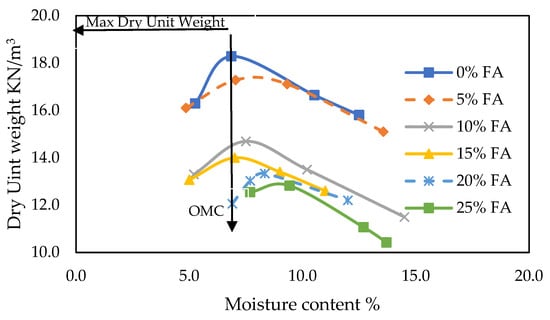
Figure 2.
Compaction curve of sand mixed with flay ash without NaOH.
2.2. Comapaction Test for Sand Mixed with Fly Ash and Water-NaOH Solution
Before the compaction test was conducted, the amount of NaOH should be determined. It was found the mass required per one liter of water using NaOH with 8 moles was equal to 320 g. Aqueous NaOH was used instead of dry NaOH to ensure uniform distribution and effective activation of fly ash during mixing. Dissolving NaOH in water allows it to act as a chemical activator, initiating the pozzolanic reaction more efficiently and improving the homogeneity of the binder throughout the soil matrix. After determining the concentration of NaOH in the water, the compaction test was conducted on sand mixed with six different percentages of fly ash (from 2.5% to 25%) with different increments using a water–NaOH solution. This range is commonly used in soil stabilization research.
The results of the compaction curve are plotted and shown in Figure 3. According to Figure 3, it was found that the maximum dry unit weight was achieved at 10% and 15% fly ash at optimum water–NaOH equal to 6.9%.
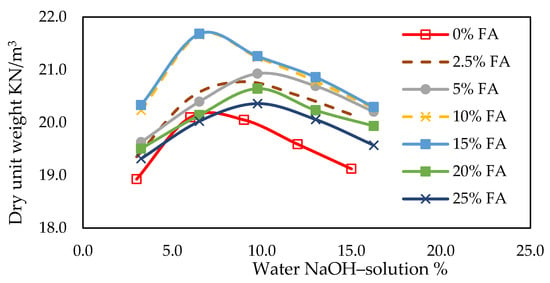
Figure 3.
Compaction curve of sand mixed with flay ash with NaOH.
2.3. Hole Erosion Test
The hole erosion test developed by Fell and Wan [] was employed to evaluate the internal erosion parameters, mainly the erosion rate index and critical shear. In this test, the soil was divided into six categories, as shown in Table 1, according to the erosion rate index. It is clear from Table 1 that the erosion rate index increased the resistance of the soil to erosion.

Table 1.
Erosion rate index categories for different erosion rate index values [].
2.4. Sample Preparation
For sand mixed with fly ash without NaOH, the specimens for each percentage of fly ash were remolded in the hole erosion test mold at 98% relative compaction and optimum water content correspondingly. For sand mixed with fly ash and water–NaOH solution, the specimens were mixed with different percentages of fly ash and remolded in the standard hole erosion test mold at 98% relative compaction from the maximum dry unit weight obtained at 10% Fly ash and 6.9% water–NaOH solution. Then, a six-millimeter diameter hole was made in the longitudinal direction of the sand remolded in the mold, and the specimens were placed in the hole erosion test. The water was allowed to flow through the 6mm hole from one direction until the sample fails. Figure 4 shows a schematic diagram of the hole erosion test.
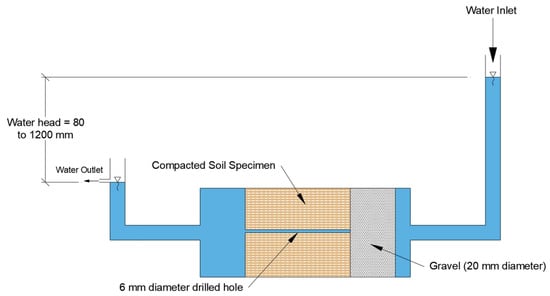
Figure 4.
Schematic diagram of the hole erosion test.
2.5. Procedure of Calculating Erosion Rate Index and Critical Shear
Based on the type of the flow, Equation (1) or Equation (2), according to Fell and Wan [], was used to determine the initial and final friction factors Ft. Ft was calculated at the beginning and the end of the test since the diameter of the hole at the beginning of the test was 6mm longer than the diameter at the end. The sample was taken out and the final diameter was measured physically by caliper. In this research, the flow was identified as turbulent; therefore, Equation (2) was used.
where
- ρw = water density used as eroding fluid, kg/m3
- g = gravitational acceleration, m/s2
- s = hydraulic gradient of the soil specimen in standard HET
- φ = diameter
- Q = rate of flow
- S =
A linear relationship between initial and final friction factors and time is plotted by interpolating the initial friction factor at t = 0.0 with the initial diameter equal 6 mm and the final friction factor at the end of the test. The diameter at any time can be calculated using Equations (3) and (4) by determining the corresponding FTt value, which can be obtained from the linear relationship between friction factor and time, as shown in Figure 5.
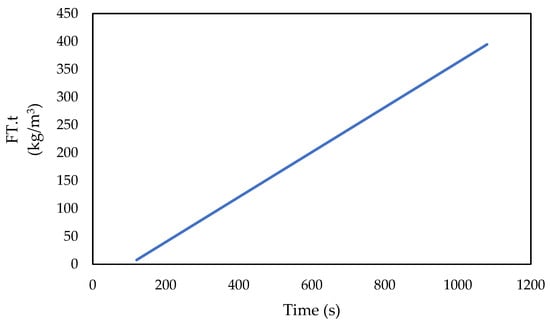
Figure 5.
Friction factor for turbulent flow (FT.t) vs. time.
Equations (4) and (5) were used to obtain and ε.t, respectively. The best fit line was plotted between the points of rate of erosion per unit area (εo) and the shear stress (τt) for different testing times, which are shown in Figure 6.
where
εt = erosion rate per unit surface area of the hole/slot at time t.
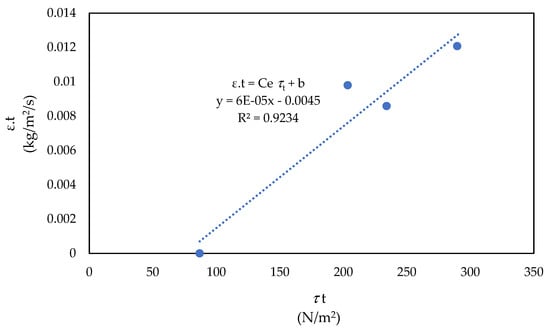
Figure 6.
Rate of erosion per unit area vs. shear stress.
The erosion rate index and the critical shear were determined using Equations (7) and (8).
where
IHET = −log (Ce)
- τt = hydraulic shear stress along with the hole/slot at time t
- Ce = coefficient of soil erosion
- τc = critical shear stress
3. Results and Discussion
3.1. Effect of Fly Ash and Fly Ash with Water Containing NaOH Solution on the Maximum Dry Unit Weight
Figure 7 shows the effect of the addition of fly ash and fly ash with NaOH on the maximum dry density and optimum water content of the sand. The results indicate that increasing fly ash content leads to a significant reduction in maximum dry density. The maximum dry unit weight decreases from 17.4 kN/m3 at 2.5% fly ash to 12.8 kN/m3 at 25% fly ash. This can be attributed to the fact that fly ash with lower specific gravity than sand resulted in decreasing the value of maximum dry unit weight.
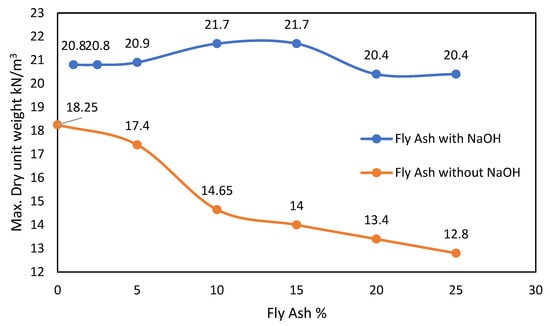
Figure 7.
Fly ash content (%) vs. maximum dry unit weight.
However, different behavior was observed due to the addition of FA with water containing NaOH on the sand. The maximum dry density increased by up to 15% and then decreased. With zero percent of fly ash and water with NaOH, the maximum dry density was 20.2 kN/m3. After the addition of fly ash with NaOH, the maximum dry density increased from 20.4 kN/m3 at 0% fly ash to 21.7 kN/m3 at 15% fly ash. It was noticed that the highest maximum dry unit weight at 10–15% has a value equal to 21.7 kN/m3. The further increase in fly ash with NaOH solution decreased the maximum dry density. The increase in dry density to up to 10–15% fly ash with NaOH is due to a chemical reaction between the fly ash and the alkaline solution, which forms cement-like materials that help fill the voids and bind the particles together. In more detail, sodium hydroxide initiates a reaction that forms cementitious compounds, such as calcium silicate hydrate (C-S-H) and calcium aluminate hydrate (C-A-H). These reaction products serve to bind soil particles and fill void spaces, resulting in a more compact soil matrix. After 15%, the extra fly ash does not fully react and replaces more sand, which increases the voids and reduces the dry density. Therefore, the best results were seen at 10–15% because of the good balance between reaction and particle packing.
It is worth mentioning that the tested samples mixed with fly ash alone were prepared at 98% relative compaction and optimum moisture content corresponding to each curve. However, the specimens containing fly ash and NaOH–water solution were prepared at 98% relative compaction, based on the highest maximum dry unit weight of 21.7 kN/m3 observed at 10% fly ash, as depicted in Figure 7.
3.2. Stabilizing Sandy Soil Against Internal Erosion Using Fly Ash
The samples were prepared following the aforementioned procedure and were tested against internal erosion. Samples contain different percentages of fly ash at 2.5%, 5%, 10%, 15%, 20%, and 25% by the dry weight of the sand. Samples were sealed for 2 days, 7 days, and 28 days to ensure the distribution of water content within soil and fly ash mixture.
3.2.1. The Effect Curing Time on the Diameter of the Erosion Hole at Different Percentages of FA
A relationship between the percentage of fly ash and the final hole diameter for the three different curing times was plotted to visualize the effect of adding fly ash on the final diameter of the soil. As shown in Figure 8, the smallest final diameter was observed at 5% and 10% fly ash for all curing durations. However, as the fly ash content increased beyond 10%, the final diameter also increased. This can be explained by the fact that as the percentage of fly ash increased, more fines were added and more potential for internal erosion occurred. These findings conclude that curing time has insignificant effects on the rate of change in the final diameter. For 2.5% of fly ash, the final diameter after 2 days curing time was 2 cm, and after 28 days, it dropped to 1.8 cm, with only a 10% reduction. Additionally, increasing fly ash content beyond 10% had an adverse effect, leading to a larger final diameter and potentially compromising overall erosion stability.
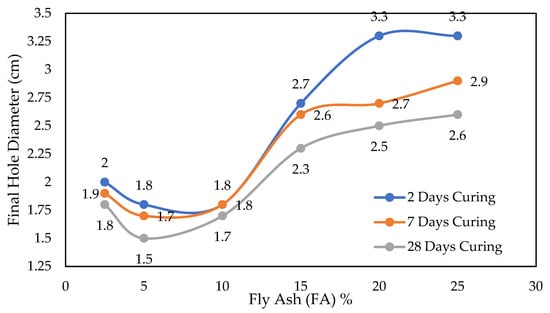
Figure 8.
Fly ash content (%) vs. final diameter at various curing times.
3.2.2. The Effect of Fly on Critical Shear Stress with Sand Mixed with Fly Ash
Figure 9 depicts the relation between the percentage of fly ash and the critical shear stress. It is clear from Figure 9 that the critical shear increased to 10% fly ash and then decreased. With the addition of 10% fly ash and 28 curing days, the critical shear stress of the soil increased to reach the largest value of 75 N/m2.
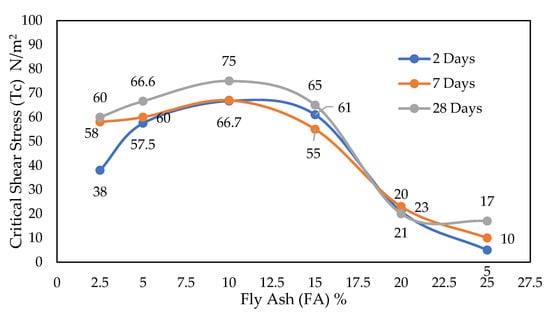
Figure 9.
Critical shear stress (Tc) vs. fly ash content (%).
Curing time also resulted in an increase in critical shear stress as it went from 66.0 N/m2 for 2 curing days to 75 N/m2 after 28 days, with an increase of 15%. However, as can be seen from Figure 9, further increases in the percentages of fly ash resulted in decreasing the critical shear stress to relatively low values.
3.2.3. The Effect of Fly Ash and Curing Time on Erosion Rate Index
As stated earlier, the erosion rate index (IHET) ranges between less than 2 and above 6, where lower values mean higher rates of erosion. Figure 10 shows the relationship between the erosion rate index and percentages of fly ash. Figure 10 shows that the highest erosion rate index was obtained at 5% fly ash. At this percentage of fly ash, the IHET ranged between 4.3 and 4.5 for the three different curing times. This implies that the curing time has no effect of the erosion rate index. Additionally, the soil is classified as moderately slow erosion according to Table 1. Furthermore, as the fly ash content increased beyond 5%, the IHET started to decrease until it reached 3.7 for the same curing period. Those values are classified as moderately rapid. Figure 10 concluded also that fly ash alone has a small effect on the erosion rate index and cannot be used alone in stabilizing the sand against internal erosion.
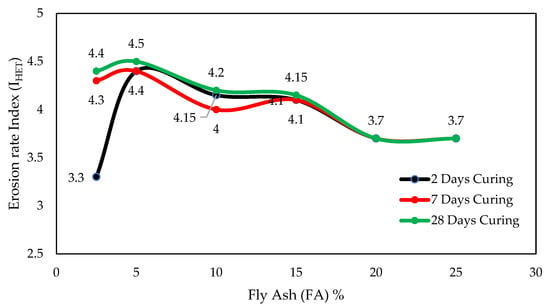
Figure 10.
Erosion rate index (IHET) vs. fly ash content (%).
3.2.4. The Relationship Between Final Diameter and Erosion Rate Index
The relationship between final diameter and erosion rate index is plotted in Figure 11. The figure reveals that for the three different curing times, as the diameter decreased, the erosion rate index increased which means that the erosion resistance increased (IHET Value increased). This result is consistent with the soil stabilization behavior since the diameter of the soil at the end of the test is smaller, indicating that the soil is resistant to erosion. Table 2 shows the erosion parameters of all tested specimens.
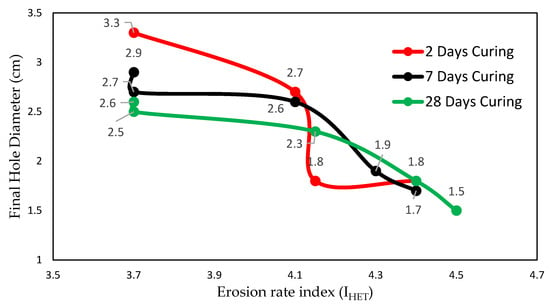
Figure 11.
Final hole diameter vs. erosion rate index (IHET).

Table 2.
Erosion parameters of all samples.
The figure clearly demonstrates an increase in final diameter due to erosion; however, the samples remained intact and did not experience structural failure.
The table summarizes the changes in erosion parameters along with the different fly ash content at 28 days curing time, including final diameter, critical shear stress, and erosion rate index. It also describes the nature of erosion for each FA percentage based on Table 1. However, Figure 12 shows the tested specimens after being subjected to water flow and internal erosion. The figure clearly demonstrates an increase in final diameter due to erosion; however, the samples remained intact and did not experience structural failure (see Table 3).
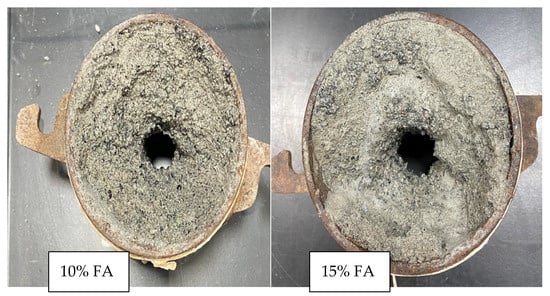
Figure 12.
Samples of 10% (left) and 15% (right) of fly ash after being tested after 28 days.

Table 3.
Summary of erosion parameters with a description of erosion for samples after 28 days curing.
3.3. Stabilizing Sandy Soil Against Internal Erosion Using Fly Ash Mixed with Sodium Hydroxide (NaOH)
The samples were prepared as explained earlier and tested against internal erosion. Specimens were prepared with 15% fly ash and different percentages of NaOH. The 15% fly ash was selected since the maximum dry unit weight is the highest at 15% fly ash. All specimens were prepared at 98% relative compaction from the maximum dry unit weight at 15% fly ash curve. Specimens were tested at 2 days, 7 days, and 28 days curing time from the time of preparation.
3.3.1. The Effect of Fly Ash Mixed with NaOH and Curing Time on the Diameter of Hole
A relationship between fly ash mixed with sodium hydroxide and the final hole diameter for different curing times was plotted to visualize the impact of FA–NaOH on the soil specimen’s diameter, as shown in Figure 13. The figure indicates that the final diameter decreased with the increase in FA-NaOH content for all percentages. Seven days curing time was the optimum time to achieve the maximum reduction for all curing time. However, Figure 13 also suggests that curing time has a minimal effect on reducing the final diameter of the eroded soil. At lower NaOH percentages, the impact of curing time is relatively small. After seven days of curing, the final diameter is nearly the same for all tested specimens, measuring approximately 0.7 mm. This suggests that soil stabilization is achieved with 10% FA–NaOH, as the final diameter increased by only 1 mm by the end of the test.
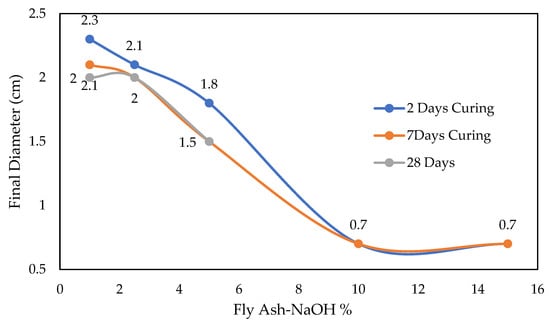
Figure 13.
Relation between FA–NaOH percentage and final diameter for different curing times.
3.3.2. The Effect of Fly Ash Mixed with NaOH and Curing Time on the Critical Shear Stress
As discussed before, the final diameter and shear stress are inversely related, as the diameter decreases, the critical shear stress will increase. Figure 14 shows that for higher percentages of fly ash mixed with NaOH, the critical shear stress increases. Testing results revealed that 15% of FA–NaOH is the optimum amount to reach the greatest critical shear stress at different curing times. With the addition of 15% FA–NaOH and curing for 7 days, the shear stress of the soil significantly increased to reach 120 N/m2, compared with 37 N/m2 for 1% of FA–NaOH with 224% increase. The curing time at 10% FA–NaOH also caused an increase in the critical shear stress as it went from 100 N/m2 for 2 days of curing time to 120 N/m2 after 7 days, with an increase of 20%. This indicated that the curing time is a significant factor in increasing the critical shear of the soil.

Figure 14.
Critical shear stress vs. FA–NaOH %.
3.3.3. The Effect of Fly Ash Mixed with NaOH and Curing Time on Erosion Rate Index
Erosion rate index (IHET) is used to classify the soil based on its behavior against erosion according to the classification method by Fan and Well []. Figure 15 illustrates the relationship between the erosion rate index and FA–NaOH content. The figure clearly shows that IHET increases with higher FA–NaOH content. Specifically, a total increase of 58% in IHET was observed when the FA–NaOH content increased from 1% to 15% after a curing period of 2 days, with IHET values rising from 3.3 to 5.2. Additionally, curing time enhanced soil stability across all FA–NaOH percentages, as depicted in Figure 15.

Figure 15.
Erosion rate index vs. FA–NaOH%.
3.3.4. Erosion Rate Index and Critical Shear Stress
The relationship between critical shear stress and the erosion rate index is illustrated in Figure 16. The plot clearly demonstrates that as the erosion rate index increases, the critical shear stress also rises, indicating an improvement in the soil’s resistance to erosion. Table 4 shows the erosion parameters of all samples for FA with NaOH. Furthermore, Table 5 summarizes the change in erosion parameters along with the change in FA-NaOH content, including final diameter, critical shear stress, and erosion rate index. It also describes the nature of erosion for each FA–NaOH content.
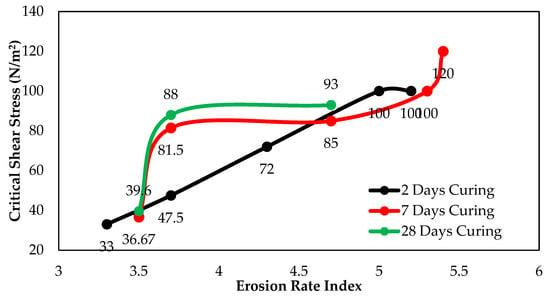
Figure 16.
Critical shear stress vs. erosion rate index.

Table 4.
Erosion parameters of all samples for FA with NaOH.

Table 5.
Summary of erosion parameters with a description of erosion for samples after 2 days of curing.
Figure 17 shows the tested specimens after being subjected to water flow and internal erosion. The figure clearly demonstrates that there is no increase in the final diameter due water; therefore, no internal erosion took place and the samples remained intact and did not experience erosion failure. This is an indication that the addition of fly ash with alkali-activated binder will stabilize the sandy soil against internal erosion.
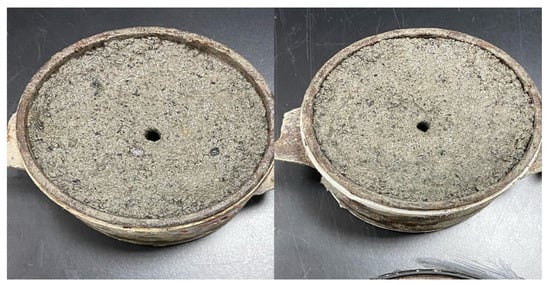
Figure 17.
Samples of 10% (left) and 15% (right) of fly ash and NaOH after being tested after 7 days.
4. Conclusions
This research was conducted to study the potential use of fly ash alone and fly ash mixed with sodium hydroxide to stabilize sandy soil against internal erosion through comprehensive experimental testing procedure. The hole erosion test (HET) apparatus was employed to achieve the objective of this research. Fly ash and fly ash mixed with sodium hydroxide were incorporated into sand at varying percentages and subjected to different curing durations to evaluate their impact on soil stabilization. Prior to conducting the Hole Erosion Test (HET), soil properties were characterized in accordance with ASTM standard procedures, including particle size distribution (ASTM D6913 []), specific gravity (ASTM D854 []), and compaction characteristics (ASTM D698 []).
This research is divided into two parts. In the first part, sandy soil was mixed with fly ash at different percentages (2.5%, 5%, 10%, 15%, 20%, and 25%) at three different curing times (2 days, 7 days, and 28 days). In the second part, sandy soil was mixed with fly ash at different percentages (1%, 2.5%, 5%, 10%, and 15%) according to the dry weight of the sand and using NaOH as liquid. The amount of NaOH liquid was selected at the optimum value from compaction curve results from mixing fly ash and NaOH. The hole erosion tests (HET) results yielded the following outcomes:
- Fly ash has a small effect on stabilizing sandy soil against internal erosion. Testing results showed that the erosion rate index increased FA content by up to 5%. However, when fly ash content increased beyond 5%, erosion rate index decreased, and the soil became more susceptible to erosion. Additionally, curing time had minimal impact on erosion resistance, with only a modest increase in the erosion rate index observed at 28 days.
- Fly ash–NaOH mixtures increased the soil maximum dry density. It was found that at 10–15% of fly ash–NaOH was the optimum value that provided the highest stability against internal erosion. Beyond this range, the dry density started to decrease, likely due to the presence of excess fly ash that did not fully react with the NaOH solution.
- Curing time had a noticeable effect when using FA–NaOH mixtures. The erosion rate index improved with longer curing periods, and the best result was obtained at 7 days of curing, which provided the most effective balance between soil strength and resistance to erosion.
- The addition of both fly ash and fly ash–NaOH mixtures increased the critical shear stress of the soil, with the fly ash–NaOH combination showing a more pronounced effect, indicating enhanced resistance to hydraulic forces responsible for initiating internal erosion.
- The FA is not effective for use with clay soil alone and activated binder should be added to FA to be effective in clay soil stabilization.
In addition to the experimental findings, this research promotes the use of fly ash, an industrial by-product, as a sustainable material for soil stabilization. Using fly ash with NaOH reduces reliance on traditional chemical stabilizers and helps improve the safety and durability of infrastructure in areas affected by erosion and flooding. The outcomes of this study support global efforts related to the United Nation (UN) Sustainable Development Goals.
Author Contributions
Conceptualization, M.A. (Mohammad Almasaeid) and M.A. (Mousa Attom); methodology, M.A. (Mohammad Almasaeid), M.A. (Mousa Attom) and M.G.A.; software, M.A. (Mohammad Almasaeid) and M.A. (Mousa Attom) and M.E.-E.; validation, M.A. (Mousa Attom), M.E.-E. and M.G.A.; formal analysis, M.A. (Mohammad Almasaeid), M.A. (Mousa Attom), M.E.-E. and M.G.A.; investigation, M.A. (Mohammad Almasaeid), M.A. (Mousa Attom), M.E.-E. and M.G.A.; resources, M.A. (Mousa Attom); data curation, M.A. (Mohammad Almasaeid), M.A. (Mousa Attom), M.E.-E. and M.G.A.; writing M.A. (Mohammad Almasaeid) and M.A. (Mousa Attom); writing—review and editing, M.A. (Mohammad Almasaeid), M.A. (Mousa Attom), M.E.-E. and M.G.A.; visualization, M.A. (Mousa Attom) and M.E.-E.; supervision, M.A. (Mousa Attom); project administration, M.A. (Mousa Attom), M.E.-E. and M.G.A.; funding acquisition, M.A. (Mousa Attom). All authors have read and agreed to the published version of the manuscript.
Funding
This research was financially supported by the American University of Sharjah (AUS) through the Faculty Research Grant program (FRG22-C-E25) and Open Access Program (OAP).
Data Availability Statement
Data are available from the corresponding author upon reasonable request.
Acknowledgments
The authors would like to acknowledge the support and contributions of the American University of Sharjah (AUS), their Civil Engineering Department staff, and the Open Access Program (OAP) during this research. This paper represents the opinions of the authors and does not represent the opinions or position of the American University of Sharjah.
Conflicts of Interest
The authors declare no conflicts of interest.
References
- Chen, S.-H. Hydraulic Structures; Springer: Berlin/Heidelberg, Germany, 2015. [Google Scholar]
- Foster, M.; Fell, R.; Spannagle, M. A method for assessing the relative likelihood of failure of embankment dams by piping. Can. Geotech. J. 2000, 37, 1025–1061. [Google Scholar] [CrossRef]
- Robbins, B.A.; Griffiths, D.V. Internal erosion of embankments: A review and appraisal. In Proceedings of the Rocky Mountain Geo-Conference, Golden, CO, USA, 2 November 2018; American Society of Civil Engineers: Reston, VA, USA, 2018; pp. 61–75. [Google Scholar]
- UC Davis’ Department of Civil and Environmental Engineering, ‘UCDAVIS Civil and Environmental Engineering’. Available online: https://research.engineering.ucdavis.edu/gpa/erosion-piping/piping-in-embankment-dams/ (accessed on 22 March 2022).
- Fell, R.; Wan, C.F.; Cyganiewicz, J.; Foster, M. Time for development of internal erosion and piping in embankment dams. J. Geotech. Geoenviron. Eng. 2003, 129, 307–314. [Google Scholar] [CrossRef]
- Banu, S.; Attom, M.; Abed, F.; Vandanapu, R.; Astillo, P.V.; Al-Lozi, N.; Khalil, A. Numerical analysis of the ultimate bearing capacity of strip footing constructed on sand-over-clay sediment. Buildings 2024, 14, 1164. [Google Scholar] [CrossRef]
- Dang, C.C.; Dang, L.C.; Khabbaz, H.; Sheng, D. Numerical study on deformation characteristics of fibre-reinforced load-transfer platform and columns-supported embankments. Can. Geotech. J. 2021, 58, 328–350. [Google Scholar] [CrossRef]
- Khalil, A.; Khan, Z.; Attom, M.; Khalafalla, O. Evaluation of Ground Improvement with Dynamic Replacement and Rapid Impact Compaction of an Artificial Island in the UAE—A Case Study. In Proceedings of the Geo-Congress 2024, Vancouver, BC, Canada, 25–28 February 2024; pp. 116–125. [Google Scholar]
- Pandey, S.; Kumari, N. Utilisation of agricultural waste biopolymer for soil erosion management. Role Green Chem. Ecosyst. Restor. Achieve Environ. Sustain. 2024, 236, 249–260. [Google Scholar]
- Briaud, J.-L. Case histories in soil and rock erosion: Woodrow wilson bridge, brazos river meander, normandy cliffs, and new orleans levees. J. Geotech. Geoenviron. Eng. 2008, 134, 1425–1447. [Google Scholar] [CrossRef]
- Sherard, J.L.; Dunnigan, L.P.; Decker, R.S.; Steele, E.F. Pinhole test for identifying dispersive soils. J. Geotech. Eng. Div. 1976, 102, 69–85. [Google Scholar] [CrossRef]
- Ke, L.; Takahashi, A. Influence of internal erosion on deformation and strength of gap-graded non-cohesive soil. In Proceedings of the Sixth International Conference on Scour and Erosion, Paris, France, 27 August–1 September 2012; pp. 847–854. [Google Scholar]
- Tomlinson, S.S.; Vaid, Y.P. Seepage forces and confining pressure effects on piping erosion. Can. Geotech. J. 2000, 37, 1–13. [Google Scholar] [CrossRef]
- Lüthi, M. A Modified Hole Erosion Test (HET-P) to Study Erosion Characteristics of Soil. Master’s Thesis, University of British Columbia, Vancouver, BC, Canada, 2011. [Google Scholar]
- Flores-Berrones, R.; Ramírez-Reynaga, M.; Macari, E.J. Internal erosion and rehabilitation of an earth-rock dam. J. Geotech. Geoenviron. Eng. 2011, 137, 150–160. [Google Scholar] [CrossRef]
- Attom, M.F.; Vandanapu, R.; Khan, Z.; Yamin, M.; Astillo, P.V.; Eltayeb, A.; Khalil, A. Prediction of internal erosion parameters of clay soils using initial physical properties. Water 2024, 16, 232. [Google Scholar] [CrossRef]
- Archibong, G.A.; Sunday, E.U.; Akudike, J.C.; Okeke, O.C.; Amadi, C. A review of the principles and methods of soil stabilization. Int. J. Adv. Acad. Res. | Sci. 2020, 6, 2488–9849. [Google Scholar]
- Banu, S.A.; Attom, M.F. Effect of curing time on lime-stabilized sandy soil against internal erosion. Geosciences 2023, 13, 102. [Google Scholar] [CrossRef]
- Banu, S.; Attom, M. Internal Erosion Stabilization of Cohesionless Soil Using Lime. Water 2023, 15, 1992. [Google Scholar] [CrossRef]
- Firoozi, A.A.; Olgun, C.G.; Firoozi, A.A.; Baghini, M.S. Fundamentals of soil stabilization. Int. J. Geo-Eng. 2017, 8, 26. [Google Scholar] [CrossRef]
- Negi, A.S.; Faizan, M.; Siddharth, D.P.; Singh, R. Soil stabilization using lime. Int. J. Innov. Res. Sci. Eng. Technol. 2013, 2, 448–453. [Google Scholar]
- Andavan, S.; Kumar, B.M. Case study on soil stabilization by using bitumen emulsions–A review. Mater. Today Proc. 2020, 22, 1200–1202. [Google Scholar] [CrossRef]
- Matthew, A.G.; Paul, A.S. Soil stabilization using Bitumen emulsion and cement combination as additive. J. Earth Sci. Eng. 2018, 8, 66–74. [Google Scholar]
- Afrin, H. A review on different types soil stabilization techniques. Int. J. Transp. Eng. Technol. 2017, 3, 19–24. [Google Scholar] [CrossRef]
- Nayem, N.H. Enhancement of Soil Characteristics Using Different Stabilization Techniques. J. Civ. Constr. Environ. Eng. 2023, 8, 71–79. [Google Scholar]
- Saravanan, R.; Murthi, P.; Poongodi, K.; Raju, A. A study on the effect of waste plastic strips in the stabilization of clay soil. In Proceedings of the IOP Conference Series: Materials Science and Engineering, Warangal, India, 9–10 October 2020; IOP Publishing: Bristol, UK, 2020; p. 032062. [Google Scholar]
- Kumari, D.; Xiang, W.-N. Review on biologically based grout material to prevent soil liquefaction for ground improvement. Int. J. Geotech. Eng. 2019, 13, 48–53. [Google Scholar] [CrossRef]
- Bhuvaneshwari, S.; Robinson, R.G.; Gandhi, S.R. Stabilization of expansive soils using fly ash. Fly Ash India 2005, 8, 1–10. [Google Scholar]
- Attom, M.; Mortula, M.M.; Munjed, A. Shear strength stabilization using burned sludge ash. Int. J. Adv. Mech. Civ. Eng. 2017, 4, 42–45. [Google Scholar]
- Ai-sharif, M.M.; Attom, M.F. A geoenvironmental application of burned wastewater sludge ash in soil stabilization. Env. Earth Sci. 2014, 71, 2453–2463. [Google Scholar] [CrossRef]
- Patil, S.C.; Mathada, D.V.S.; Bharamagoud, B. Comparative study on black cotton soil stabilization by using lime and sisal fiber. Int. J. Innov. Res. Sci. Technol. 2018, 5, 109–115. [Google Scholar]
- Zafar, T.; Ansari, M.A.; Husain, A. Soil stabilization by reinforcing natural and synthetic fibers–A state of the art review. Mater. Today Proc. 2023. [Google Scholar] [CrossRef]
- Amena, S.; Chakeri, D. A study on the effects of plastic waste strips and lime on strength characteristics of expansive soil. Adv. Civ. Eng. 2022, 2022, 6952525. [Google Scholar] [CrossRef]
- Radwan, M.K.H.; Lee, F.W.; Woon, Y.B.; Yew, M.K.; Mo, K.H.; Wai, S.H. A study of the strength performance of peat soil: A modified cement-based stabilization agent using fly ash and polypropylene fiber. Polymers 2021, 13, 4059. [Google Scholar] [CrossRef]
- Hemanth, T.R.S.S.; Sharma, V. Strength and compaction behavior of copper slag stabilized soil. Mater Today Proc. 2023, 93, 505–509. [Google Scholar] [CrossRef]
- Hanson, G.J. Development of a jet index to characterize erosion resistance of soils in earthen spillways. Trans. ASAE 1991, 34, 2015–2020. [Google Scholar] [CrossRef]
- Khalil, A.; Khan, Z.; Attom, M.; Fattah, K.; Ali, T.; Mortula, M. Continuous Evaluation of Shear Wave Velocity from Bender Elements during Monotonic Triaxial Loading. Materials 2023, 16, 766. [Google Scholar] [CrossRef]
- Amiralian, S.; Chegenizadeh, A.; Nikraz, H. A review on the lime and fly ash application in soil stabilization. Int. J. Biol. Ecol. Environ. Sci. 2012, 1, 124–126. [Google Scholar]
- Mateos, M. Stabilization of soils with fly ash alone. Highw. Res. Rec. 1964, 52, 59–65. [Google Scholar]
- Mahvash, S.; López-Querol, S.; Bahadori-Jahromi, A. Effect of class F fly ash on fine sand compaction through soil stabilization. Heliyon 2017, 3, e00274. [Google Scholar] [CrossRef]
- Nath, B.D.; Molla, M.K.A.; Sarkar, G. Study on strength behavior of organic soil stabilized with fly ash. Int. Sch. Res. Not. 2017, 2017, 5786541. [Google Scholar] [CrossRef]
- Dickens, M.M. Organisation for Economic Co-operation and Development; OECD: Paris, France, 2006. [Google Scholar]
- Basu, M.; Pande, M.; Bhadoria, P.B.S.; Mahapatra, S.C. Potential fly-ash utilization in agriculture: A global review. Prog. Nat. Sci. 2009, 19, 1173–1186. [Google Scholar] [CrossRef]
- Moore, W.L.; Masch, F.D. Experiments on the scour resistance of cohesive sediments. J. Geophys. Res. 1962, 67, 1437–1446. [Google Scholar] [CrossRef]
- Wan, C.F.; Fell, R. Investigation of rate of erosion of soils in embankment dams. J. Geotech. Geoenviron. Eng. 2004, 130, 373–380. [Google Scholar] [CrossRef]
- Farrar, J.A.; Torres, R.L.; Erdogan, Z. Bureau of reclamation erosion testing for evaluation of piping and internal erosion of dams. In Proceedings of the Geotechnics of soil Erosion, Denver, CO, USA, 18 February 2007; pp. 1–10. [Google Scholar]
- Coudert, E.; Deneele, D.; Russo, G.; Vitale, E.; Tarantino, A. Microstructural evolution and mechanical behaviour of alkali activated fly ash binder treated clay. Constr. Build. Mater. 2021, 285, 122917. [Google Scholar] [CrossRef]
- Wang, H.; Liu, T.; Yan, C.; Wang, J. Expansive soil stabilization using alkali-activated fly ash. Processes 2023, 11, 1550. [Google Scholar] [CrossRef]
- Vitale, E.; Marocco, A.; Khatib, M.; Russo, G. Hydro-mechanical behaviour of alkali-activated binder treated soil. In Proceedings of the E3S Web of Conferences, Kenitra, Morocco, 25–27 December 2020; EDP Sciences: Les Ulis, France, 2020; p. 06003. [Google Scholar]
- Coudert, E.; Paris, M.; Deneele, D.; Russo, G.; Tarantino, A. Use of alkali activated high-calcium fly ash binder for kaolin clay soil stabilisation: Physicochemical evolution. Constr. Build. Mater. 2019, 201, 539–552. [Google Scholar] [CrossRef]
- Zuaiter, M.; Khalil, A.; Elkafrawy, M.; Hawileh, R.; AlHamaydeh, M.; Ayman, A.; Kim, T.-Y. Effect of blending GGBS and silica fume on the mechanical properties of geopolymer concrete. Sci. Rep. 2025, 15, 9091. [Google Scholar] [CrossRef] [PubMed]
- ASTM D6913/D6913M-17; Standard Test Methods for Particle-Size Distribution (Gradation) of Soils Using Sieve Analysis. ASTM International: West Conshohocken, PA, USA, 2017.
- ASTM D854-22; Standard Test Methods for Specific Gravity of Soil Solids by Water Pycnometer. ASTM International: West Conshohocken, PA, USA, 2022.
- ASTM D698-23; Standard Test Methods for Laboratory Compaction Characteristics of Soil Using Standard Effort (12,400 ft-lbf/ft3 or 600 kN-m/m3). ASTM International: West Conshohocken, PA, USA, 2023.
Disclaimer/Publisher’s Note: The statements, opinions and data contained in all publications are solely those of the individual author(s) and contributor(s) and not of MDPI and/or the editor(s). MDPI and/or the editor(s) disclaim responsibility for any injury to people or property resulting from any ideas, methods, instructions or products referred to in the content. |
© 2025 by the authors. Licensee MDPI, Basel, Switzerland. This article is an open access article distributed under the terms and conditions of the Creative Commons Attribution (CC BY) license (https://creativecommons.org/licenses/by/4.0/).